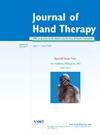背侧阻断矫形器治疗近端指间关节伏板损伤:一项回顾性队列研究,探讨关节角度对患者预后的影响。
IF 1.8
4区 医学
Q2 ORTHOPEDICS
引用次数: 0
摘要
背景:手指近端指间关节(PIPJ)损伤是手部治疗部门的常见治疗方法。PIPJ 伏板损伤的保守治疗通常包括背侧阻滞矫形器和屈曲运动。目的:比较两组接受背侧阻滞矫形器治疗的结果:研究设计:回顾性队列研究:研究设计:回顾性队列研究:研究对象包括澳大利亚墨尔本一家大型都市医院网络的手部治疗服务部门在三年内保守治疗 PIPJ 伏板损伤的患者。我们收集了有关患者人口统计学特征、受影响的手指和损伤类型的数据。研究结果包括是否存在固定屈曲畸形(FFD)、接受手部治疗的次数以及 PIPJ 的总主动屈曲度:我们的研究共纳入了 111 名参与者。平均年龄为 26 岁,男性 59 人(占 53%)。72名参与者(64%)接受了中立位背侧阻滞矫形器,39名参与者(35%)PIPJ屈曲25-30°。与将 PIPJ 置于中立位的参与者相比,将矫形器置于 25-30° 位置的参与者平均多接受了 24 分钟的手部治疗(约等于一次预约)(p=0.006,d=0.5)。在接受背侧阻滞矫形器置于中立位的组别中,出现FFD的参与者减少了8%(p=0.24),实现完全屈曲的参与者增加了13%(p=0.06),但这些结果并无统计学意义:结论:使用中立位矫形器治疗 PIPJ 伏板损伤所需的手部治疗预约次数较少。结论:使用中立位矫形器治疗 PIPJ 外侧钢板损伤的患者所需的手部治疗预约次数更少,而在 FFD 或完全屈曲的发展方面,各组之间的差异没有统计学意义。本文章由计算机程序翻译,如有差异,请以英文原文为准。
Dorsal blocking orthoses for proximal interphalangeal joint volar plate injuries: A retrospective cohort study investigating the impact of joint angle on patient outcomes
Background
Injuries to the proximal interphalangeal joint (PIPJ) of the fingers are commonly treated in hand therapy departments. Conservative management for PIPJ volar plate injuries typically involves a dorsal blocking orthosis and flexion exercises. Historically hand therapists have placed the PIPJ in varying degrees of flexion but the optimal angle is unknown.
Purpose
To compare the outcomes of two treatment groups who received dorsal blocking orthoses: Those who the orthosis was positioned in neutral compared to those in 25–30° of flexion.
Study Design
Retrospective cohort study.
Method
Patients treated by the hand therapy service at a major metropolitan hospital network in Melbourne, Australia, for conservative management of a PIPJ volar plate injury over a three-year period were included in our study. Data regarding patient demographics, digits affected and injury type were collected. Outcomes included presence of a fixed flexion deformity (FFD), amount of hand therapy received and total active flexion at the PIPJ.
Results
One hundred and eleven participants were included in our study. The mean age was 26 and 59 (53%) were males. Seventy two (64%) participants received a dorsal blocking orthosis positioned in neutral and 39 (35%) were positioned in 25–30° flexion at the PIPJ. Participants whose orthosis was positioned at 25–30° had an average of 24 more minutes in hand therapy (which equates to approximately one appointment) compared to those whose PIPJ was positioned in neutral (p = 0.006, d = 0.5). Eight percent less participants developed a FFD (p = 0.24) and 13% more participants achieved full flexion (p = 0.06) in the group who received a dorsal blocking orthosis in neutral, however these results were not statistically significant.
Conclusion
PIPJ volar plate injures treated in an orthosis positioned in neutral required fewer hand therapy appointments. There was no statistically significant difference between groups regarding development of a FFD or full flexion.
求助全文
通过发布文献求助,成功后即可免费获取论文全文。
去求助
来源期刊

Journal of Hand Therapy
医学-外科
CiteScore
3.50
自引率
10.00%
发文量
65
审稿时长
19.2 weeks
期刊介绍:
The Journal of Hand Therapy is designed for hand therapists, occupational and physical therapists, and other hand specialists involved in the rehabilitation of disabling hand problems. The Journal functions as a source of education and information by publishing scientific and clinical articles. Regular features include original reports, clinical reviews, case studies, editorials, and book reviews.
 求助内容:
求助内容: 应助结果提醒方式:
应助结果提醒方式:


